Fundamentals of Intellectual Property Law in Singapore Assignment
VerifiedAdded on 2022/08/12
|7
|1626
|33
Homework Assignment
AI Summary
This assignment addresses a case study involving intellectual property rights in Singapore, focusing on trademark infringement, patent infringement, and copyright issues. The analysis examines a scenario where a company, R&P Pte Ltd, faces competition from a rival, Charles, who launches a similar product under a potentially infringing name. The assignment explores whether Charles is liable under the Trademark Act, 1998, and the Patent Act, 1994, and the Copyright Act, 1987, considering the similarity of names, products, and content. It investigates remedies available to R&P Pte Ltd for infringement, including damages and injunctive relief. Furthermore, the assignment analyzes the risks and options for an individual, John, considering acquiring R&P Pte Ltd's business, specifically focusing on franchise licensing as a preferred method for investment, and the importance of assessing the value of IP rights. The solution provides detailed legal arguments, referencing relevant sections of the Acts and case law, and concludes with a summary of the liabilities and options for the parties involved.
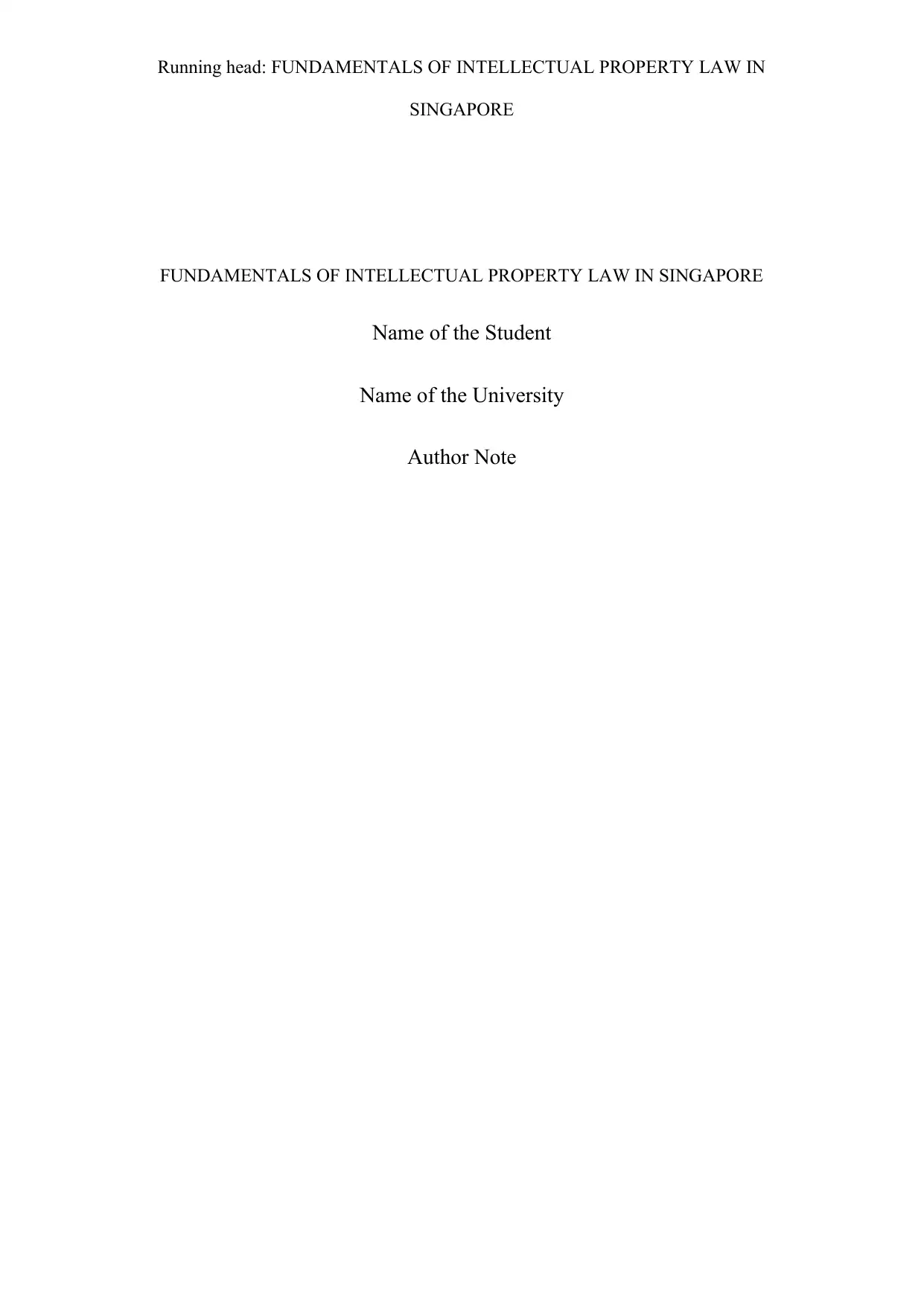
Running head: FUNDAMENTALS OF INTELLECTUAL PROPERTY LAW IN
SINGAPORE
FUNDAMENTALS OF INTELLECTUAL PROPERTY LAW IN SINGAPORE
Name of the Student
Name of the University
Author Note
SINGAPORE
FUNDAMENTALS OF INTELLECTUAL PROPERTY LAW IN SINGAPORE
Name of the Student
Name of the University
Author Note
Paraphrase This Document
Need a fresh take? Get an instant paraphrase of this document with our AI Paraphraser
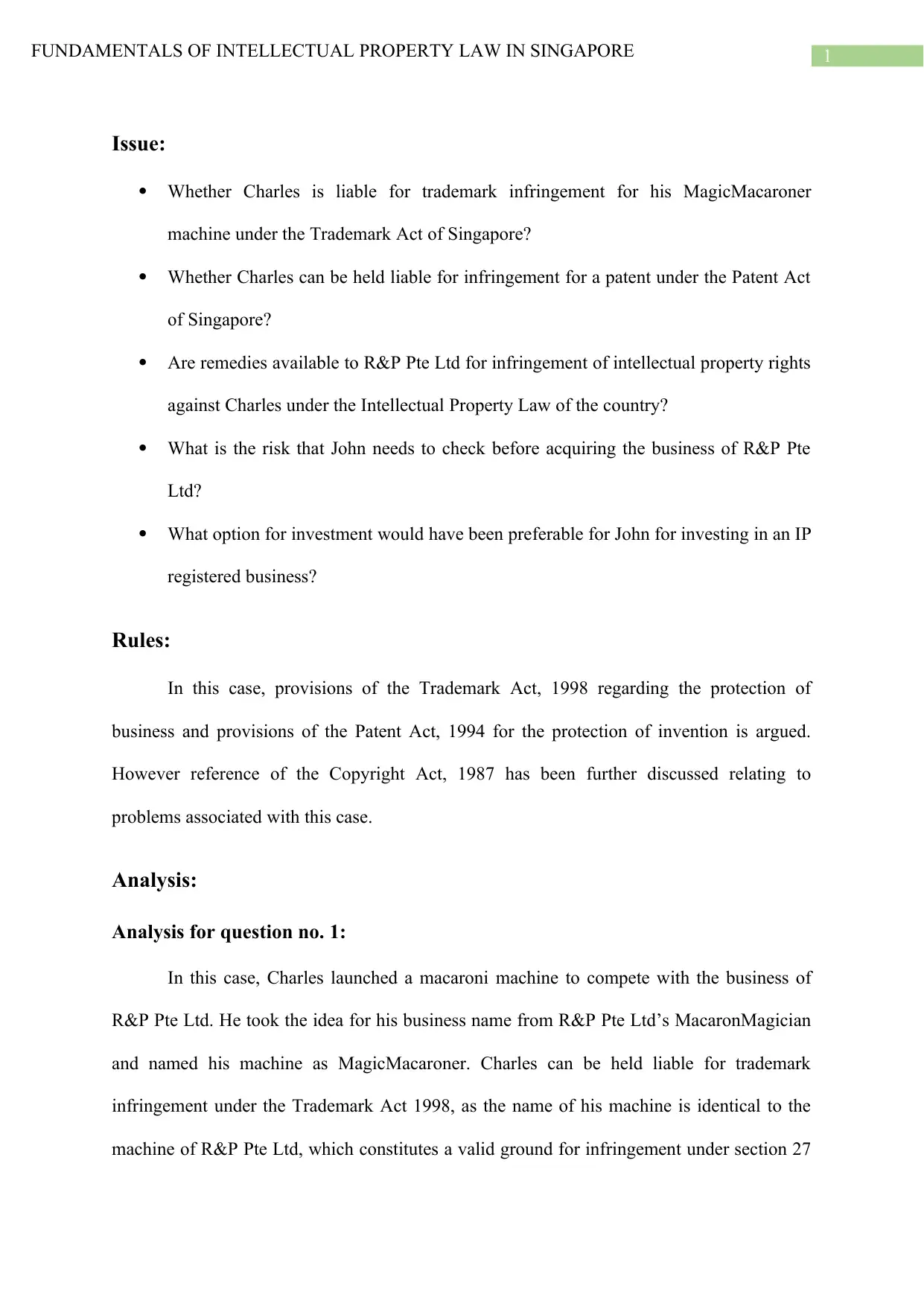
1FUNDAMENTALS OF INTELLECTUAL PROPERTY LAW IN SINGAPORE
Issue:
Whether Charles is liable for trademark infringement for his MagicMacaroner
machine under the Trademark Act of Singapore?
Whether Charles can be held liable for infringement for a patent under the Patent Act
of Singapore?
Are remedies available to R&P Pte Ltd for infringement of intellectual property rights
against Charles under the Intellectual Property Law of the country?
What is the risk that John needs to check before acquiring the business of R&P Pte
Ltd?
What option for investment would have been preferable for John for investing in an IP
registered business?
Rules:
In this case, provisions of the Trademark Act, 1998 regarding the protection of
business and provisions of the Patent Act, 1994 for the protection of invention is argued.
However reference of the Copyright Act, 1987 has been further discussed relating to
problems associated with this case.
Analysis:
Analysis for question no. 1:
In this case, Charles launched a macaroni machine to compete with the business of
R&P Pte Ltd. He took the idea for his business name from R&P Pte Ltd’s MacaronMagician
and named his machine as MagicMacaroner. Charles can be held liable for trademark
infringement under the Trademark Act 1998, as the name of his machine is identical to the
machine of R&P Pte Ltd, which constitutes a valid ground for infringement under section 27
Issue:
Whether Charles is liable for trademark infringement for his MagicMacaroner
machine under the Trademark Act of Singapore?
Whether Charles can be held liable for infringement for a patent under the Patent Act
of Singapore?
Are remedies available to R&P Pte Ltd for infringement of intellectual property rights
against Charles under the Intellectual Property Law of the country?
What is the risk that John needs to check before acquiring the business of R&P Pte
Ltd?
What option for investment would have been preferable for John for investing in an IP
registered business?
Rules:
In this case, provisions of the Trademark Act, 1998 regarding the protection of
business and provisions of the Patent Act, 1994 for the protection of invention is argued.
However reference of the Copyright Act, 1987 has been further discussed relating to
problems associated with this case.
Analysis:
Analysis for question no. 1:
In this case, Charles launched a macaroni machine to compete with the business of
R&P Pte Ltd. He took the idea for his business name from R&P Pte Ltd’s MacaronMagician
and named his machine as MagicMacaroner. Charles can be held liable for trademark
infringement under the Trademark Act 1998, as the name of his machine is identical to the
machine of R&P Pte Ltd, which constitutes a valid ground for infringement under section 27
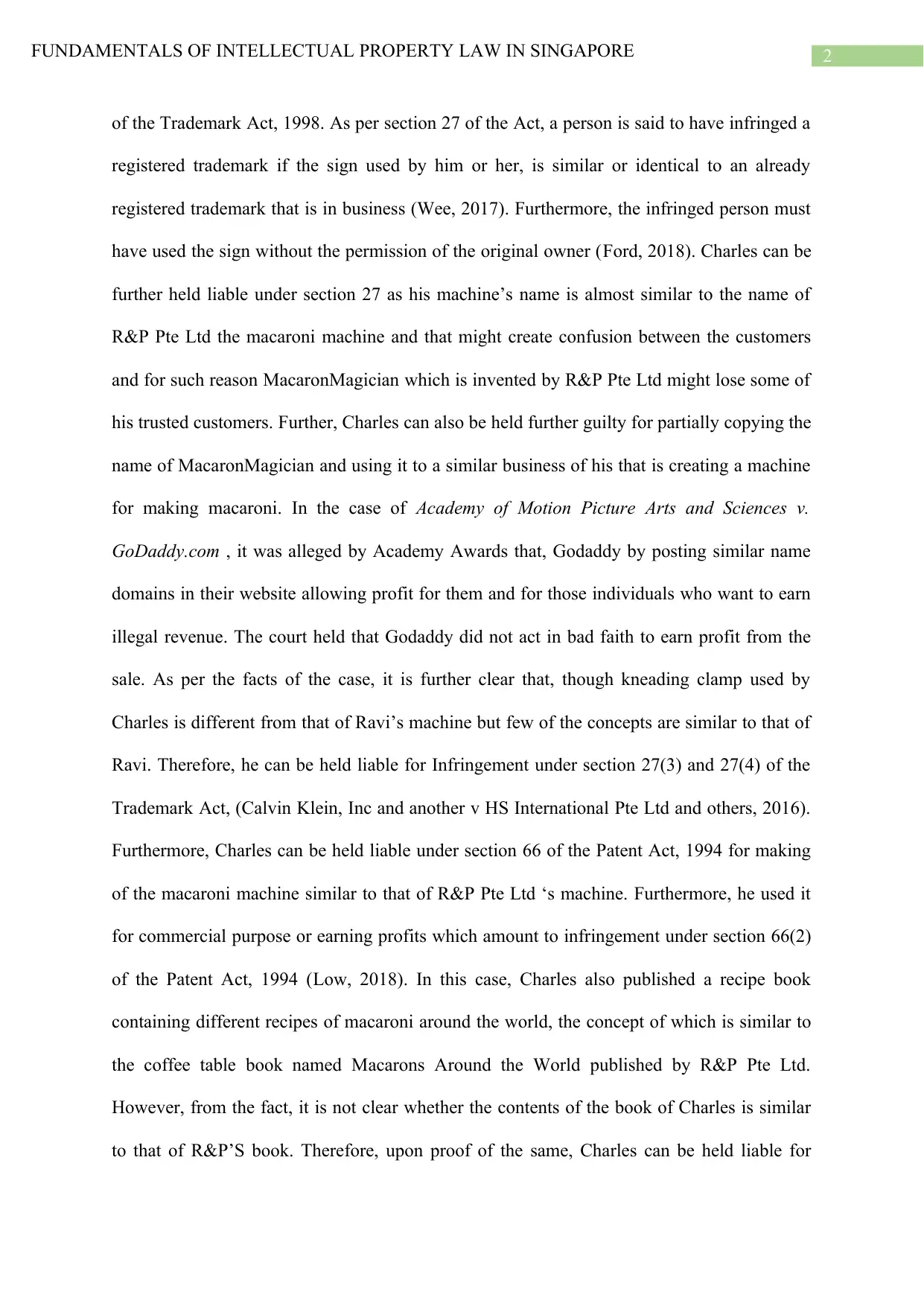
2FUNDAMENTALS OF INTELLECTUAL PROPERTY LAW IN SINGAPORE
of the Trademark Act, 1998. As per section 27 of the Act, a person is said to have infringed a
registered trademark if the sign used by him or her, is similar or identical to an already
registered trademark that is in business (Wee, 2017). Furthermore, the infringed person must
have used the sign without the permission of the original owner (Ford, 2018). Charles can be
further held liable under section 27 as his machine’s name is almost similar to the name of
R&P Pte Ltd the macaroni machine and that might create confusion between the customers
and for such reason MacaronMagician which is invented by R&P Pte Ltd might lose some of
his trusted customers. Further, Charles can also be held further guilty for partially copying the
name of MacaronMagician and using it to a similar business of his that is creating a machine
for making macaroni. In the case of Academy of Motion Picture Arts and Sciences v.
GoDaddy.com , it was alleged by Academy Awards that, Godaddy by posting similar name
domains in their website allowing profit for them and for those individuals who want to earn
illegal revenue. The court held that Godaddy did not act in bad faith to earn profit from the
sale. As per the facts of the case, it is further clear that, though kneading clamp used by
Charles is different from that of Ravi’s machine but few of the concepts are similar to that of
Ravi. Therefore, he can be held liable for Infringement under section 27(3) and 27(4) of the
Trademark Act, (Calvin Klein, Inc and another v HS International Pte Ltd and others, 2016).
Furthermore, Charles can be held liable under section 66 of the Patent Act, 1994 for making
of the macaroni machine similar to that of R&P Pte Ltd ‘s machine. Furthermore, he used it
for commercial purpose or earning profits which amount to infringement under section 66(2)
of the Patent Act, 1994 (Low, 2018). In this case, Charles also published a recipe book
containing different recipes of macaroni around the world, the concept of which is similar to
the coffee table book named Macarons Around the World published by R&P Pte Ltd.
However, from the fact, it is not clear whether the contents of the book of Charles is similar
to that of R&P’S book. Therefore, upon proof of the same, Charles can be held liable for
of the Trademark Act, 1998. As per section 27 of the Act, a person is said to have infringed a
registered trademark if the sign used by him or her, is similar or identical to an already
registered trademark that is in business (Wee, 2017). Furthermore, the infringed person must
have used the sign without the permission of the original owner (Ford, 2018). Charles can be
further held liable under section 27 as his machine’s name is almost similar to the name of
R&P Pte Ltd the macaroni machine and that might create confusion between the customers
and for such reason MacaronMagician which is invented by R&P Pte Ltd might lose some of
his trusted customers. Further, Charles can also be held further guilty for partially copying the
name of MacaronMagician and using it to a similar business of his that is creating a machine
for making macaroni. In the case of Academy of Motion Picture Arts and Sciences v.
GoDaddy.com , it was alleged by Academy Awards that, Godaddy by posting similar name
domains in their website allowing profit for them and for those individuals who want to earn
illegal revenue. The court held that Godaddy did not act in bad faith to earn profit from the
sale. As per the facts of the case, it is further clear that, though kneading clamp used by
Charles is different from that of Ravi’s machine but few of the concepts are similar to that of
Ravi. Therefore, he can be held liable for Infringement under section 27(3) and 27(4) of the
Trademark Act, (Calvin Klein, Inc and another v HS International Pte Ltd and others, 2016).
Furthermore, Charles can be held liable under section 66 of the Patent Act, 1994 for making
of the macaroni machine similar to that of R&P Pte Ltd ‘s machine. Furthermore, he used it
for commercial purpose or earning profits which amount to infringement under section 66(2)
of the Patent Act, 1994 (Low, 2018). In this case, Charles also published a recipe book
containing different recipes of macaroni around the world, the concept of which is similar to
the coffee table book named Macarons Around the World published by R&P Pte Ltd.
However, from the fact, it is not clear whether the contents of the book of Charles is similar
to that of R&P’S book. Therefore, upon proof of the same, Charles can be held liable for
⊘ This is a preview!⊘
Do you want full access?
Subscribe today to unlock all pages.

Trusted by 1+ million students worldwide
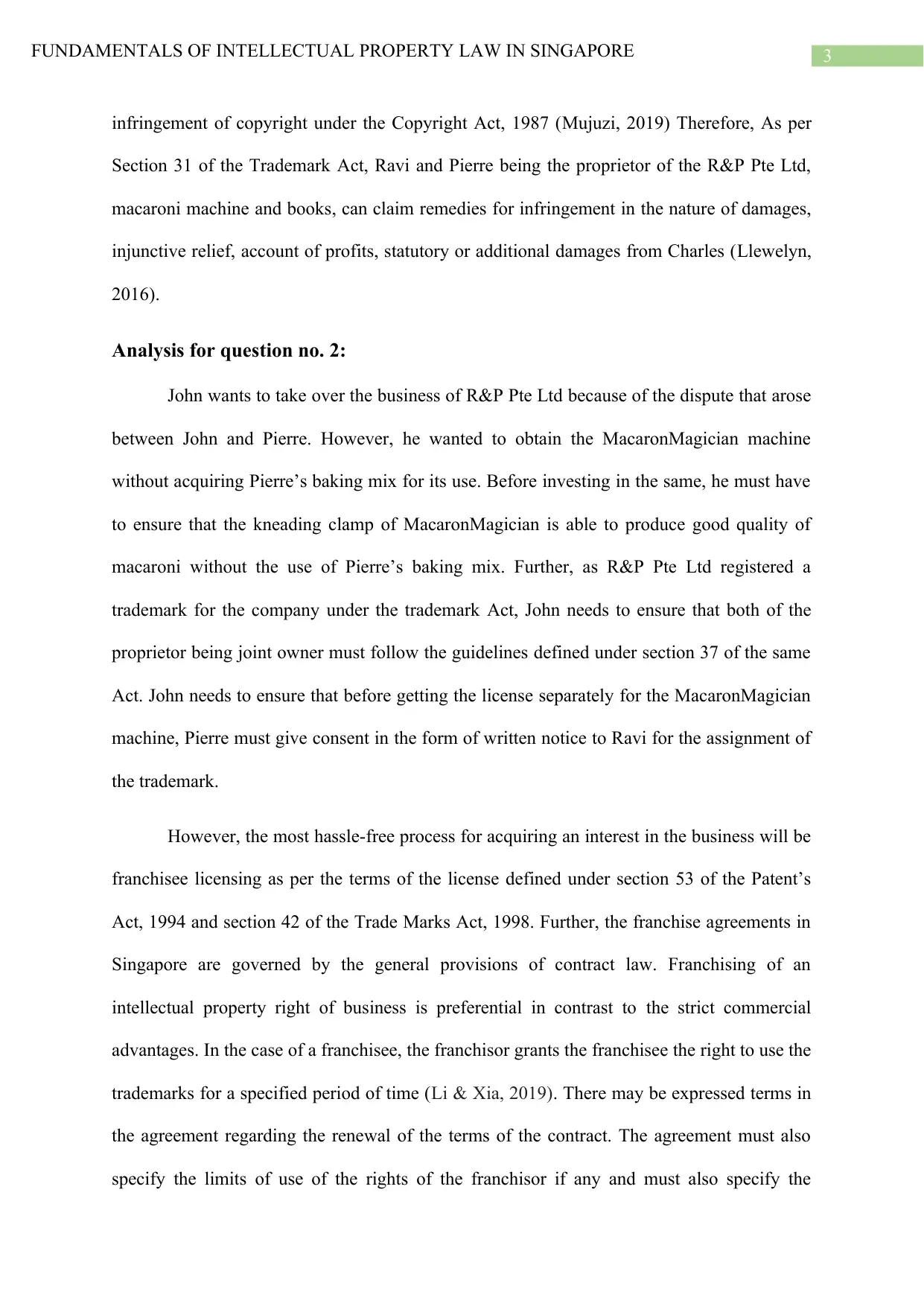
3FUNDAMENTALS OF INTELLECTUAL PROPERTY LAW IN SINGAPORE
infringement of copyright under the Copyright Act, 1987 (Mujuzi, 2019) Therefore, As per
Section 31 of the Trademark Act, Ravi and Pierre being the proprietor of the R&P Pte Ltd,
macaroni machine and books, can claim remedies for infringement in the nature of damages,
injunctive relief, account of profits, statutory or additional damages from Charles (Llewelyn,
2016).
Analysis for question no. 2:
John wants to take over the business of R&P Pte Ltd because of the dispute that arose
between John and Pierre. However, he wanted to obtain the MacaronMagician machine
without acquiring Pierre’s baking mix for its use. Before investing in the same, he must have
to ensure that the kneading clamp of MacaronMagician is able to produce good quality of
macaroni without the use of Pierre’s baking mix. Further, as R&P Pte Ltd registered a
trademark for the company under the trademark Act, John needs to ensure that both of the
proprietor being joint owner must follow the guidelines defined under section 37 of the same
Act. John needs to ensure that before getting the license separately for the MacaronMagician
machine, Pierre must give consent in the form of written notice to Ravi for the assignment of
the trademark.
However, the most hassle-free process for acquiring an interest in the business will be
franchisee licensing as per the terms of the license defined under section 53 of the Patent’s
Act, 1994 and section 42 of the Trade Marks Act, 1998. Further, the franchise agreements in
Singapore are governed by the general provisions of contract law. Franchising of an
intellectual property right of business is preferential in contrast to the strict commercial
advantages. In the case of a franchisee, the franchisor grants the franchisee the right to use the
trademarks for a specified period of time (Li & Xia, 2019). There may be expressed terms in
the agreement regarding the renewal of the terms of the contract. The agreement must also
specify the limits of use of the rights of the franchisor if any and must also specify the
infringement of copyright under the Copyright Act, 1987 (Mujuzi, 2019) Therefore, As per
Section 31 of the Trademark Act, Ravi and Pierre being the proprietor of the R&P Pte Ltd,
macaroni machine and books, can claim remedies for infringement in the nature of damages,
injunctive relief, account of profits, statutory or additional damages from Charles (Llewelyn,
2016).
Analysis for question no. 2:
John wants to take over the business of R&P Pte Ltd because of the dispute that arose
between John and Pierre. However, he wanted to obtain the MacaronMagician machine
without acquiring Pierre’s baking mix for its use. Before investing in the same, he must have
to ensure that the kneading clamp of MacaronMagician is able to produce good quality of
macaroni without the use of Pierre’s baking mix. Further, as R&P Pte Ltd registered a
trademark for the company under the trademark Act, John needs to ensure that both of the
proprietor being joint owner must follow the guidelines defined under section 37 of the same
Act. John needs to ensure that before getting the license separately for the MacaronMagician
machine, Pierre must give consent in the form of written notice to Ravi for the assignment of
the trademark.
However, the most hassle-free process for acquiring an interest in the business will be
franchisee licensing as per the terms of the license defined under section 53 of the Patent’s
Act, 1994 and section 42 of the Trade Marks Act, 1998. Further, the franchise agreements in
Singapore are governed by the general provisions of contract law. Franchising of an
intellectual property right of business is preferential in contrast to the strict commercial
advantages. In the case of a franchisee, the franchisor grants the franchisee the right to use the
trademarks for a specified period of time (Li & Xia, 2019). There may be expressed terms in
the agreement regarding the renewal of the terms of the contract. The agreement must also
specify the limits of use of the rights of the franchisor if any and must also specify the
Paraphrase This Document
Need a fresh take? Get an instant paraphrase of this document with our AI Paraphraser
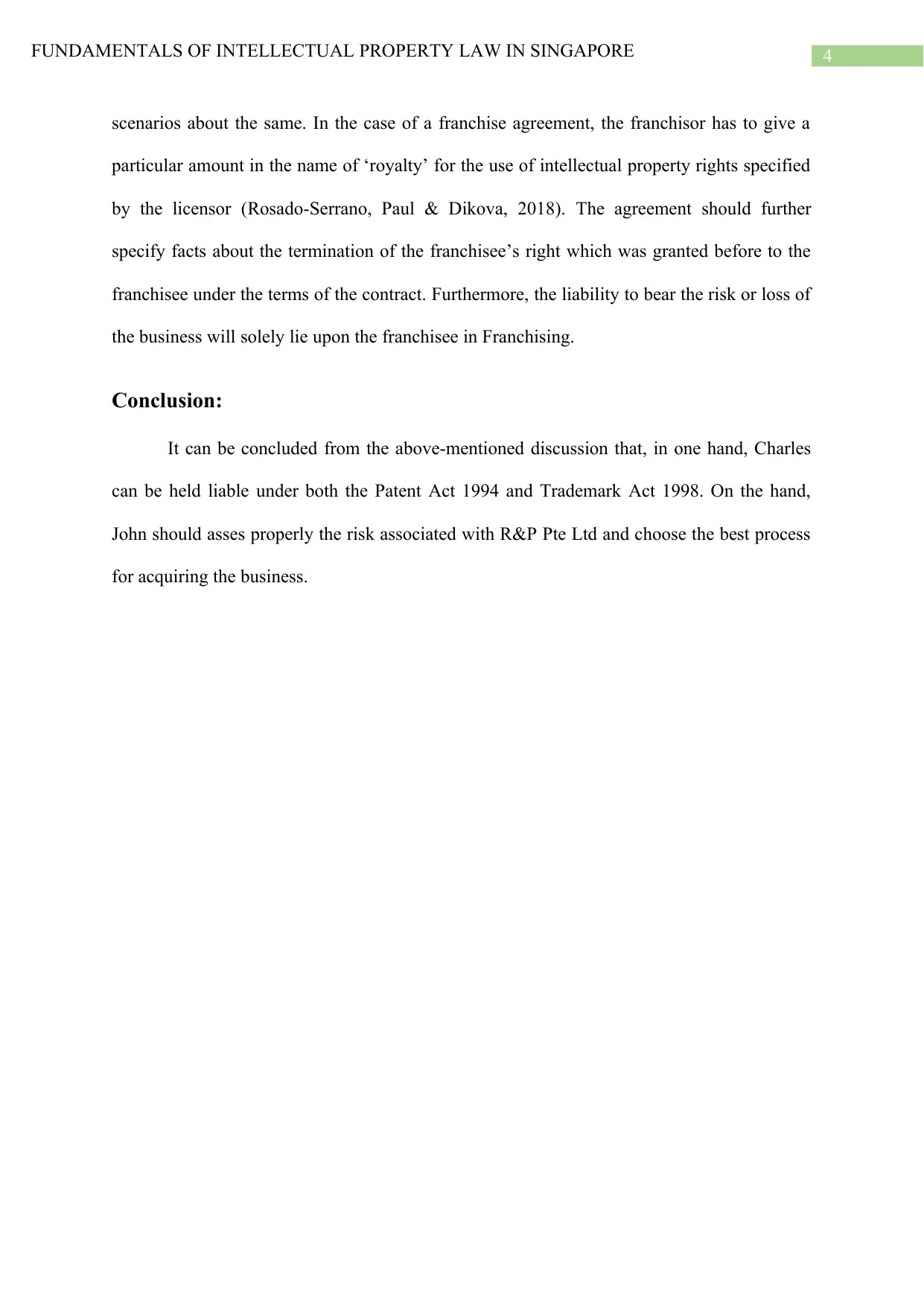
4FUNDAMENTALS OF INTELLECTUAL PROPERTY LAW IN SINGAPORE
scenarios about the same. In the case of a franchise agreement, the franchisor has to give a
particular amount in the name of ‘royalty’ for the use of intellectual property rights specified
by the licensor (Rosado-Serrano, Paul & Dikova, 2018). The agreement should further
specify facts about the termination of the franchisee’s right which was granted before to the
franchisee under the terms of the contract. Furthermore, the liability to bear the risk or loss of
the business will solely lie upon the franchisee in Franchising.
Conclusion:
It can be concluded from the above-mentioned discussion that, in one hand, Charles
can be held liable under both the Patent Act 1994 and Trademark Act 1998. On the hand,
John should asses properly the risk associated with R&P Pte Ltd and choose the best process
for acquiring the business.
scenarios about the same. In the case of a franchise agreement, the franchisor has to give a
particular amount in the name of ‘royalty’ for the use of intellectual property rights specified
by the licensor (Rosado-Serrano, Paul & Dikova, 2018). The agreement should further
specify facts about the termination of the franchisee’s right which was granted before to the
franchisee under the terms of the contract. Furthermore, the liability to bear the risk or loss of
the business will solely lie upon the franchisee in Franchising.
Conclusion:
It can be concluded from the above-mentioned discussion that, in one hand, Charles
can be held liable under both the Patent Act 1994 and Trademark Act 1998. On the hand,
John should asses properly the risk associated with R&P Pte Ltd and choose the best process
for acquiring the business.
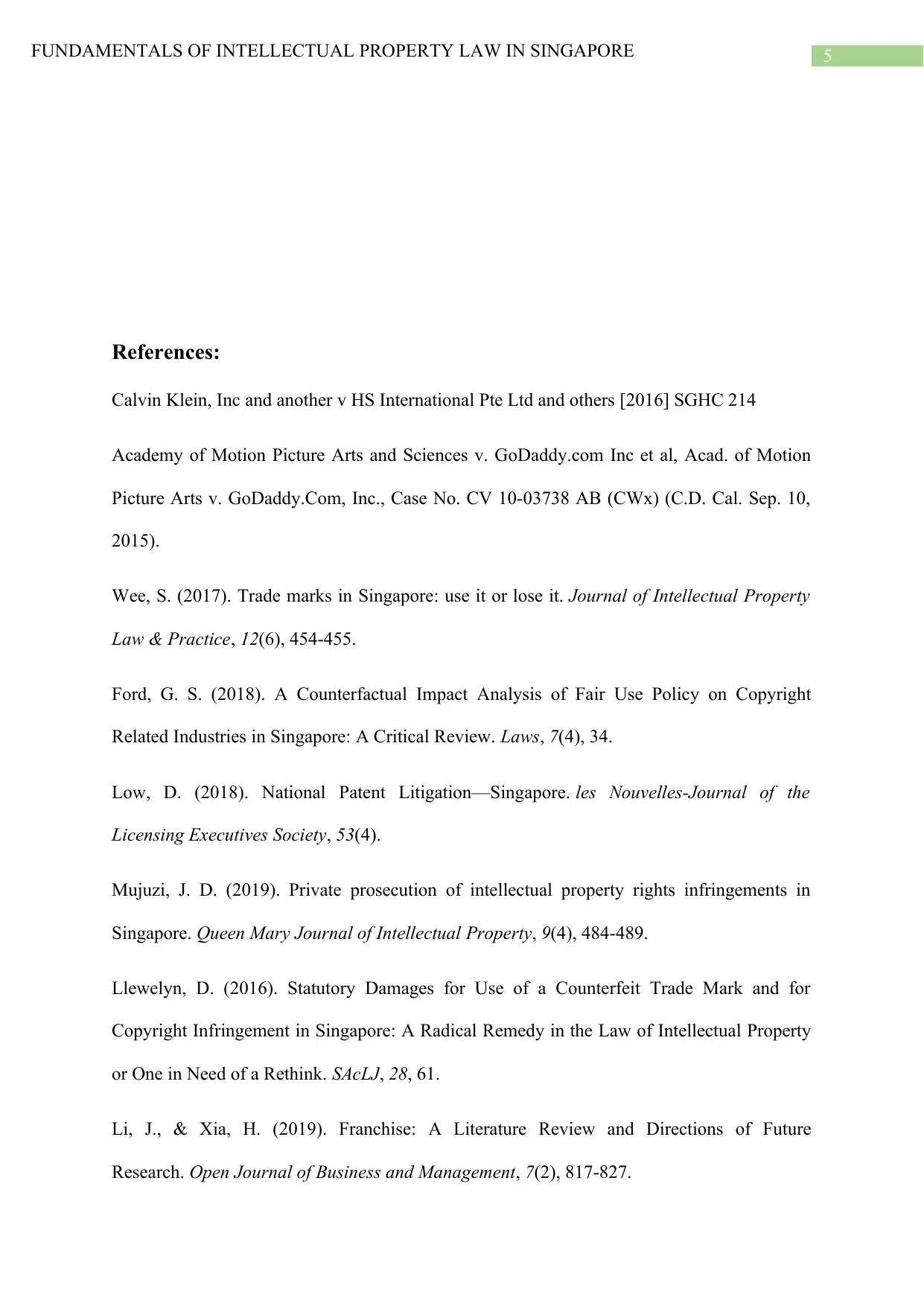
5FUNDAMENTALS OF INTELLECTUAL PROPERTY LAW IN SINGAPORE
References:
Calvin Klein, Inc and another v HS International Pte Ltd and others [2016] SGHC 214
Academy of Motion Picture Arts and Sciences v. GoDaddy.com Inc et al, Acad. of Motion
Picture Arts v. GoDaddy.Com, Inc., Case No. CV 10-03738 AB (CWx) (C.D. Cal. Sep. 10,
2015).
Wee, S. (2017). Trade marks in Singapore: use it or lose it. Journal of Intellectual Property
Law & Practice, 12(6), 454-455.
Ford, G. S. (2018). A Counterfactual Impact Analysis of Fair Use Policy on Copyright
Related Industries in Singapore: A Critical Review. Laws, 7(4), 34.
Low, D. (2018). National Patent Litigation—Singapore. les Nouvelles-Journal of the
Licensing Executives Society, 53(4).
Mujuzi, J. D. (2019). Private prosecution of intellectual property rights infringements in
Singapore. Queen Mary Journal of Intellectual Property, 9(4), 484-489.
Llewelyn, D. (2016). Statutory Damages for Use of a Counterfeit Trade Mark and for
Copyright Infringement in Singapore: A Radical Remedy in the Law of Intellectual Property
or One in Need of a Rethink. SAcLJ, 28, 61.
Li, J., & Xia, H. (2019). Franchise: A Literature Review and Directions of Future
Research. Open Journal of Business and Management, 7(2), 817-827.
References:
Calvin Klein, Inc and another v HS International Pte Ltd and others [2016] SGHC 214
Academy of Motion Picture Arts and Sciences v. GoDaddy.com Inc et al, Acad. of Motion
Picture Arts v. GoDaddy.Com, Inc., Case No. CV 10-03738 AB (CWx) (C.D. Cal. Sep. 10,
2015).
Wee, S. (2017). Trade marks in Singapore: use it or lose it. Journal of Intellectual Property
Law & Practice, 12(6), 454-455.
Ford, G. S. (2018). A Counterfactual Impact Analysis of Fair Use Policy on Copyright
Related Industries in Singapore: A Critical Review. Laws, 7(4), 34.
Low, D. (2018). National Patent Litigation—Singapore. les Nouvelles-Journal of the
Licensing Executives Society, 53(4).
Mujuzi, J. D. (2019). Private prosecution of intellectual property rights infringements in
Singapore. Queen Mary Journal of Intellectual Property, 9(4), 484-489.
Llewelyn, D. (2016). Statutory Damages for Use of a Counterfeit Trade Mark and for
Copyright Infringement in Singapore: A Radical Remedy in the Law of Intellectual Property
or One in Need of a Rethink. SAcLJ, 28, 61.
Li, J., & Xia, H. (2019). Franchise: A Literature Review and Directions of Future
Research. Open Journal of Business and Management, 7(2), 817-827.
⊘ This is a preview!⊘
Do you want full access?
Subscribe today to unlock all pages.

Trusted by 1+ million students worldwide
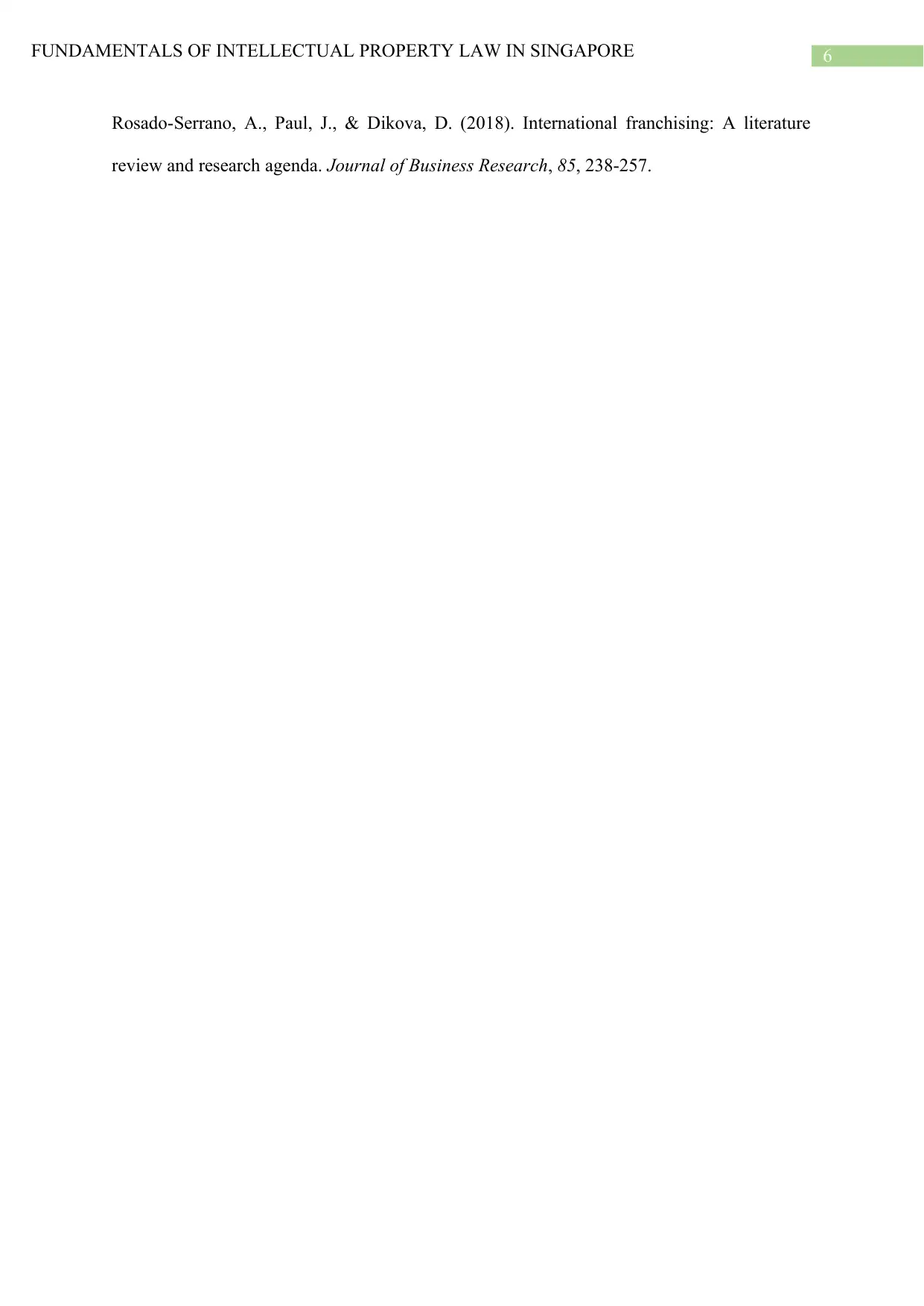
6FUNDAMENTALS OF INTELLECTUAL PROPERTY LAW IN SINGAPORE
Rosado-Serrano, A., Paul, J., & Dikova, D. (2018). International franchising: A literature
review and research agenda. Journal of Business Research, 85, 238-257.
Rosado-Serrano, A., Paul, J., & Dikova, D. (2018). International franchising: A literature
review and research agenda. Journal of Business Research, 85, 238-257.
1 out of 7
Related Documents
Your All-in-One AI-Powered Toolkit for Academic Success.
+13062052269
info@desklib.com
Available 24*7 on WhatsApp / Email
![[object Object]](/_next/static/media/star-bottom.7253800d.svg)
Unlock your academic potential
Copyright © 2020–2025 A2Z Services. All Rights Reserved. Developed and managed by ZUCOL.





